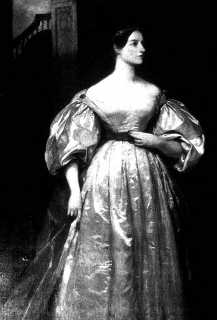

|
The First Programmer: Ada Augusta
One important exception was the figure of Ada Augusta, Countess of Lovelace. Ada not only understood the brilliance of Babbage's design for the Analytical Engine; she also tried to illustrate this to others. Ironically, Ada was the daughter of Lord Byron, who penned a number of works that were very critical of Industrial Revolution technologies and their adverse effects upon the quality of human life.
 Ada
herself designed many sequences of Babbage's machine's basic operations
that added up to substantive mathematical computations. For this reason,
she is often called the first programmer.
Impressively, she made use of a number of software design elements (such as
the loop, in which an operation is repeated until a certain condition
occurs) that are now fundamental to all programming languages.
Ada
herself designed many sequences of Babbage's machine's basic operations
that added up to substantive mathematical computations. For this reason,
she is often called the first programmer.
Impressively, she made use of a number of software design elements (such as
the loop, in which an operation is repeated until a certain condition
occurs) that are now fundamental to all programming languages.
Ada's significance to the history of computing was marked by the naming of a programming language in her honor: Ada, developed in 1983 by the United States Department of Defense (with a follow-up version later, called Ada95).
 Ada
was also the subject of a 1997 film by Lynn Hershman-Leeson, Conceiving
Ada.
Ada
was also the subject of a 1997 film by Lynn Hershman-Leeson, Conceiving
Ada.
Ada is only one of many important (and, sadly, underrecognized) women in the history of computing.
![]()
![]()
These pages were written by Steven H. VanderLeest and Jeffrey Nyhoff and edited by Nancy Zylstra
©2005 Calvin University (formerly Calvin College), All Rights Reserved
If you encounter technical errors, contact computing@calvin.edu.